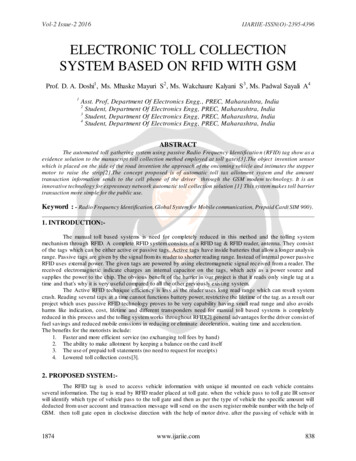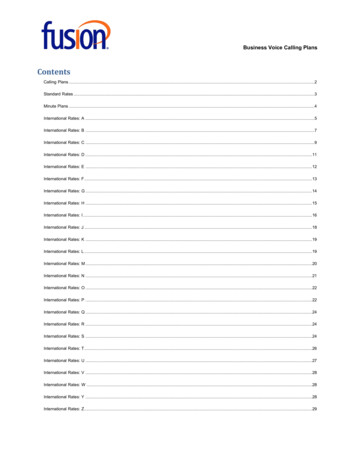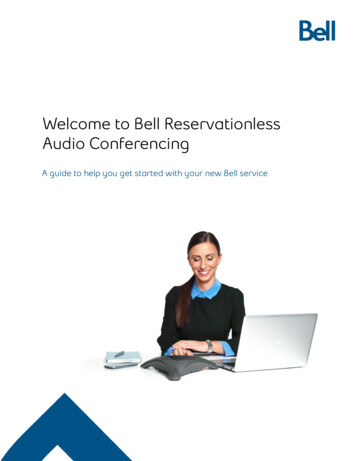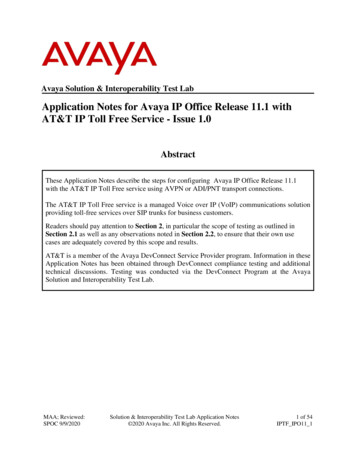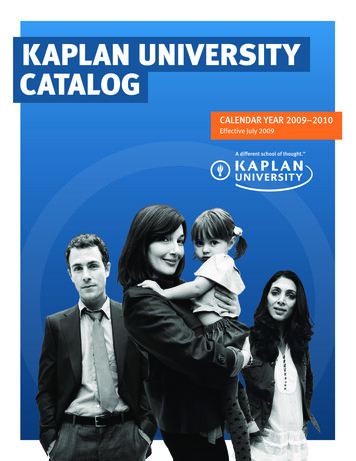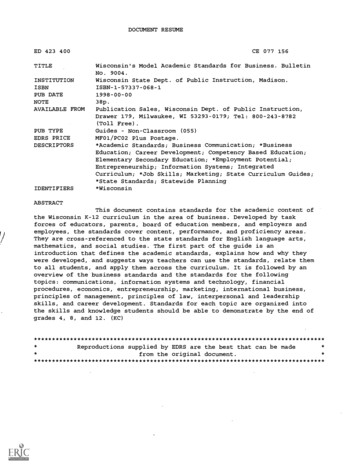
Transcription
DOCUMENT RESUMEED 423 400TITLEINSTITUTIONISBNPUB DATENOTEAVAILABLE FROMCE 077 156Wisconsin's Model Academic Standards for Business. BulletinNo. 9004.Wisconsin State Dept. of Public Instruction, n Sales, Wisconsin Dept. of Public Instruction,Drawer 179, Milwaukee, WI 53293-0179; Tel: 800-243-8782(Toll Free).PUB TYPEEDRS PRICEDESCRIPTORSIDENTIFIERSGuidesNon-Classroom (055)MF01/PCO2 Plus Postage.*Academic Standards; Business Communication; *BusinessEducation; Career Development; Competency Based Education;Elementary Secondary Education; *Employment Potential;Entrepreneurship; Information Systems; IntegratedCurriculum; *Job Skills; Marketing; State Curriculum Guides;*State Standards; Statewide Planning*WisconsinABSTRACTThis document contains standards for the academic content ofthe Wisconsin K-12 curriculum in the area of business. Developed by taskforces of educators, parents, board of education members, and employers andemployees, the standards cover content, performance, and proficiency areas.They are cross-referenced to the state standards for English language arts,mathematics, and social studies. The first part of the guide is anintroduction that defines the academic standards, explains how and why theywere developed, and suggests ways teachers can use the standards, relate themto all students, and apply them across the curriculum. It is followed by anoverview of the business standards and the standards for the followingtopics: communications, information systems and technology, financialprocedures, economics, entrepreneurship, marketing, international business,principles of management, principles of law, interpersonal and leadershipskills, and career development. Standards for each topic are organized intothe skills and knowledge students should be able to demonstrate by the end ofgrades 4, 8, and 12. **********************************Reproductions supplied by EDRS are the best that can be madefrom the original ***************************************
00(-4aWISCONSIN'S MODELACADEMIC STANDARDS FOR'"ViThrL.,(1J.-7 -i.'-. -et .7 4&aiiikt,.--:.-.----i ,fl--,"tralg.dddid-- -OF EDUCATIONU.S. DEPARTMENTResearch and ImprovementINFORMATIONEDUCATIONAL RESOURCESCENTER (ERIC)ashas been reproduced0 This documentreceived from the person or organizationoriginating it.have been made to0 Minor changesqualityimprove reproduction11.Office of EducanonalthisPoints of view or opinions stated indocument do not necessanly representofficial OERI positron Or policy'V'PERMISSION TO REPRODUCE ANDDISSEMINATE THIS MATERIAL HASBEEN GRANTED BY.dtd4TO THE EDUCATIO A RESOURCESINFORMATION E TER (ERIC)1Li)Wisconsin Department of Public InstructionBEST COPY AVAILABLE i
Wisconsin's Model AcademicStandards for BusinessJohn D. FortierAssistant State SuperintendentDivision for Learning Support: Instructional ServicesBryan D. AlbrechtDirectorLifework Education TeamSusan M. GradyDirectorContent and Learning TeamJoan W. LoockConsultantBusiness EducationdeoDPIJohn T. BensonState SuperintendentWisconsin Department of Public InstructionMadison, Wisconsin
00000This publication is available fromPublication SalesWisconsin Department of Public InstructionDrawer 179Milwaukee WI 53293-0179(800) 243-8782Bulletin No. 9004ISBN 1-57337-068-1 1998 by Wisconsin Department of Public InstructionThe Wisconsin Department of Public Instruction does not discriminate on the basis ofsex, race, religion, age, national origin, ancestry, creed, pregnancy, marital or parentalstatus, sexual orientation or physical, mental, emotional or learning disability.Printed on recycled paper.4ii WISCONSIN'S MODEL ACADEMIC STANDARDS
Table of ContentsLetter from the State SuperintendentAcknowledgmentsvi iIntroductionixOverview of Business1A. Communications2Written CommunicationOral CommunicationWorkplace CommunicationB. Information Systems/Technology6C. Financial Procedures8D. Economics10E. Entrepreneurship12F.Marketing14G. International Business16H. Principles of Management18I.Principles of Law20J.Interpersonal and Leadership Skills22K. Career Development245WISCONSIN'S MODEL ACADEMIC STANDARDS iii
A Letter From the State SuperintendentTo the Citizens of Wisconsin:Wisconsin has long been a model for other states in terms of education quality. However, the world israpidly becoming a more complex place. As a result, we must expect greater academic achievementfrom our children today if they are to be adequately prepared for the challenges of tomorrow.The only way to ensure that Wisconsin's students have the skills and abilities to be successful in thisrapidly changing technological world is to set clear, high academic standards that describe preciselywhat today's students must learn and be able to do in order to be successful in their adult lives. This iswhy we focused our efforts over the past two years creating model academic standards in all subjectareas. While Wisconsin's Model Academic Standards do demand more of our students, we are confident that our students are equal to the task.These model academic standards represent the work of a task force made up of people from diversebackgrounds. Educators, parents, and business people produced the academic content and performance standards in this document. Drafts were subjected to public engagement in which many additional people offered input.It must be stressed that these standards are not intended to limit local districts. Instead they are amodel to be met or exceeded. Our hope is that the standards will shape teaching and learning inWisconsin's more than 2000 school buildings. The standards will define the criteria by which one canjudge the quality of education programs. While many schools already have clearly defined high academic standards, many others may wish to review and perhaps change their learning goals and teaching methods.Standards logically provide the foundation for testing; and, testing results are a critical barometer ofboth student and teacher success. Local tests that are well-aligned to the standards are a clear indicator of students' preparation for future education, civic responsibility, and meaningful employment.In closing, I want to commend the members of the task force who gave freely of their time to producethe standards in this document. Finally, the citizens of Wisconsin must be thanked for devoting theirtime and effort to the development of the final draft of Wisconsin's Model Academic Standards.State Superintendent6WISCONSIN'S MODEL ACADEMIC STANDARDS V
OOOOOOOOOOOAcknowledgmentsWisconsin's Model Academic Standards for Business would not have been possible without the efforts ofmany people. Members of the task force freely gave their time and expertise in developing the academicstandards. In addition, their employing agencies generously granted them time to work on this initiative.The task force members areMary Jane Best-Louther, DirectorCenter for Education and Workforce CompetitivenessUniversity of Wisconsin-Green BayPete NewtonSchool CounselorWausau West High SchoolMichael Carpenter, PresidentWisconsin Business Education AssociationTeacherBaraboo High SchoolAnnette O'HernBusiness Education TeacherSchool-to-Work CoordinatorSchool District of LaCrosseThomas Dock, DeanCollege of BusinessUniversity of Wisconsin-Eau ClaireJudy Olson-Sutton, President-ElectNational Business Education AssociationMadison Area Technical CollegeWinnie Doxsie, First Vice PresidentWisconsin PTAAppletonRon SchlattmanProfessor of Business CommunicationUniversity of Wisconsin-Eau ClaireLinda Cate DunaheeAssistant Director of Instructional ServicesSusan SharkeyBusiness Education TeacherRipon High SchoolCESA 10Chippewa FallsSheri FermanichSchool-to-Work CoordinatorSchool District of MiddletonSherrie StuessyBusiness Education TeacherBelleville High SchoolMichael J. TokheimMarcia L. James, ChairpersonBusiness Education/Office Systems DepartmentUniversity of Wisconsin-WhitewaterEducation ConsultantWisconsin Technical College System BoardMadisonJudy Ann JonesMathematics InstructorMadison Area Technical CollegeBrenda J. WhiteBusiness Education TeacherAlexander Hamilton High SchoolMilwaukeeErica McIntire Kauten, State DirectorWisconsin Small Business Development CenterMadisonDon Zahn, Task Force ChairAssociate Dean of BusinessUniversity of Wisconsin-WhitewaterSpecial thanks to James S. Haney, President, Wisconsin Manufacturers & Commerce, for his review andcomments representing business and industry in Wisconsin; Ann Zucker and Mary Rowlette, MiddletonSchool District, representing elementary and middle school education; and Lynn Meihack, WhitehallSchool District; Kristin Matchey, Arcadia High School; and Lisa Perry, Blair-Taylor High School, for thecross-referencing of the business standards with the state assessed subjects.Also, special thanks to Greg Doyle, Kathy Addie, Donna Collingwood, Amy French, Victoria Horn, BeverlyKniess, Sandi Ness, Terd Otto, Edy Paske, and Tammy Wylesky.WISCONSIN'S MODEL ACADEMIC STANDARDS vii
IntroductionDefining the Academic StandardsWhat are academic standards? Academic standards specify what students should know and be able to do,what they might be asked to do to give evidence of standards, and how well they must perform. They include content, performance, and proficiency standards.Content standards refer to what students should know and be able to do.Performance standards tell how students will show that they are meeting a standard.Proficiency standards indicate how well students must perform.Why are academic standards necessary? Standards serve as rigorous goals for teaching and learning. Setting high standards enables students, parents, educators, and citizens to know what students should havelearned at a given point in time. The absence of standards has consequences similar to lack of goals in anypursuit. Without clear goals, students may be unmotivated and confused.Contemporary society is placing immense academic demands on students. Clear statements about whatstudents must know and be able to do are essential to ensure that our schools offer students the opportunity to acquire the knowledge and skills necessary for success.Why are state-level academic standards important? Public education is a state responsibility. The statesuperintendent and legislature must ensure that all children have equal access to high quality educationprograms. At a minimum, this requires clear statements of what all children in the state should know andbe able to do as well as evidence that students are meeting these expectations. Furthermore, academic standards form a sound basis on which to establish the content of a statewide assessment system.Why does Wisconsin need its own academic standards? Historically, the citizens of Wisconsin are veryserious and thoughtful about education. They expect and receive very high performance from theirschools. While educational needs may be similar among states, values differ. Standards should reflect thecollective values of the citizens and be tailored to prepare young people for economic opportunities thatexist in Wisconsin, the nation, and the world.Developing the Academic StandardsWho wrote the academic standards and what resources were used? Academic standards for the nonstate-assessed subjects were drafted by task forces appointed by the state superintendent. The task forcesconsisted of educators, parents, board of education members, and business and industry people. After reviewing national standards in the subject area, standards from other states, and standards from local Wisconsin school districts, each task force diligently and thoughtfully composed the academic standards for itsrespective subject.How was the public involved in the standards process? Public input is crucial to the success of implementing high-quality standards. It was absolutely essential that the final academic standards reflect thevalues of Wisconsin's citizens.Forums, focus groups, and input on the discussion drafts of the academic standards were used for getting citizens' ideas. Drafts of the standards were widely available throughout the stateincluding the DPIhome page available on the Internet. All input received serious consideration.a WISCONSIN'S MODEL ACADEMIC STANDARDS ix
0600000000000000Using the Academic StandardsMust a district adopt Wisconsin's Model Academic Standards? Adopting Wisconsin's Model AcademicStandards is voluntary, not mandatory. By law, however, districts must have academic standards in placeby August 1, 1998, in reading and writing, geography and history, mathematics, and science. Districts mayadopt the model state standards, or standards from other sources, or develop their own standards. Although not required by law to have standards in the other subjects, districts may choose to adopt or develop academic standards in those areas as well.How will local districts use the academic standards? Districts may use the academic standards as guidesfor developing local grade-by-grade curriculum. Implementing standards may require some school districtsto upgrade schodl and district curriculums. In some cases, this may result in significant changes in instructional methods and materials, local assessments, and professional development opportunities for theteaching and administrative staff.Do academic standards in the vocational areas mean that districts need to offer electives in thesesubjects at the elementary and middle school levels? Most subjects are developmentalthey build uponpreviously learned knowledge and skills. In addition, subjects include knowledge and skills that are of greatvalue to all students regardless of their future life and career plans.The model academic content and performance standards developed for the vocational areas includesubject matter that all students should learn. In many cases, students are already learning these in elementary and middle school. The academic standards for vocational areas are a means to assist teachers inknowing if they are meeting the needs of students by preparing them for future opportunities.With the academic standards in vocational areas at the fourth and eighth grade levels, it is not expectednew elective courses will need to be instituted. Current middle and high school vocational teachers are encouraged to work with elementary and middle school teachers from other subject areas to connect curriculum experiences.Why do some of the subjects also benchmark for "emphasis students" as well as for grades 4, 8, and12? Most subjects include knowledge and skills that are of great value to all students. Identified knowledgeand skills should be part of the performance standards for all students. In addition, some vocational subjects include more in-depth knowledge and skills that are necessary for specific applications. Studentsshould be able to pursue courses requiring in-depth knowledge and skills that are consistent with their lifeand career plans. The standards directed at "emphasis students" address a much higher level of performance in that subject.How do DPI skill standards fit with the academic standards currently being developed? Academiccontent, performance, and proficiency standards focus on expectations about what all students shouldknow and be able to do, how they will show that they have met the standards, and at what level or qualityof performance.Skill standards include content from multiple disciplines and define what productive workers in an occupational cluster or industry sector need to know and be able to do.What is the difference between academic standards and curriculum? Standards are statements aboutwhat students should know and be able to do, what they might be asked to do to give evidence of learning, and how well they should be expected to know or do it. Curriculum is the program devised by localschool districts used to prepare students to meet standards. It consists of activities and lessons at eachgrade level, instructional materials, and various instructional techniques. In short, standards define what isto be learned at certain points in time, and from a broad perspective, what performances will be acceptedas evidence that the learning has occurred. Curriculum specifies the details of the day-to-day schooling atthe local level.What is the link between statewide academic standards and statewide testing? Statewide academicstandards in mathematics, English language arts, science, and social studies determine the scope of state-X WISCONSIN'S MODEL ACADEMIC STANDARDS9
wide testing. While these standards are much broader in content than any single Wisconsin Student Assessment System (WSAS) test, they do describe the range of knowledge and skills that may appear on thetests. If content does not appear in the academic standards, it will not be part of a WSAS test. The statewidestandards clarify what must be studied to prepare for WSAS tests. If students have learned all of the material indicated by the standards in the assessed content areas, they should do very well on the state tests.Relating the Academic Standards to All StudentsParents and educators of students with disabilities, with limited English proficiency (LEP), and with accelerated needs may ask why academic standards are important for their students. Academic standards serveas a valuable basis for establishing meaningful goals as part of each student's developmental progress anddemonstration of proficiency. The clarity of academic standards provides meaningful, concrete goals forthe achievement of students with disabilities, LEP, and accelerated needs consistent with all other students.Academic standards may serve as the foundation for individualized programming decisions for studentswith disabilities, LEP, and accelerated needs. While the vast majority of students with disabilities and LEPshould be expected to work toward and achieve these standards, accommodations and modifications tohelp these students reach the achievement goals will need to be individually identified and implemented.For students with disabilities, these decisions are made as part of their individualized education program(IEP) plans. Accelerated students may achieve well beyond the academic standards and move into advanced grade levels or into advanced coursework.Clearly, these academic standards are for all students. As our state assessments are aligned with thesestandards and school districts adopt, adapt, or develop their own standards and multiple measures for determining proficiencies of students, greater accountability for the progress of all students can be assured. InWisconsin this means all students reaching their full individual potential, every school being accountable,every parent a welcomed partner, every community supportive, and no excuses.Applying the Academic Standards Across the CurriculumWhen community members and employers consider what they want citizens and employees to know andbe able to do, they often speak of broad areas of applied knowledge such as communication, thinking,problem-solving, and decision-making. These areas connect or go beyond the mastery of individual subjectareas. As students apply their knowledge both within and across the various curricular areas, they developthe concepts and complex thinking of educated persons.Community members need these skills to function as responsible citizens. Employers prize thoseemployees who demonstrate these skills because they are people who can continue learning and connectwhat they have learned to the requirements of a job. College and university faculty recognize the need forthese skills as the means of developing the level of understanding that separates the expert from thebeginner.Teachers in every class should expect and encourage the development of these shared applications,both to promote the learning of the subject content and to extend learning across the curriculum. Theseapplications fall into five general categories:1) Application of the Basics3) Skill in Communication2) Ability to ThinkProblem-solvingInformed decision-makingSystems thinkingCritical, creative, and analytical thinkingImagining places, times, and situations different from one's ownDeveloping and testing a hypothesisTransferring learning to new situationsConstructing and defending an argumentWorking effectively in groupsCommunicating plans and processes forreaching goalsReceiving and acting on instructions, plans,and modelsCommunicating with a variety of tools andskills1 0 WISCONSIN'S MODEL ACADEMIC STANDARDS Xi
0094) Production of Quality WorkAcquiring and using informationCreating quality products and performancesRevising products and performancesDeveloping and pursuing positive goalsXii WISCONSIN'S MODEL ACADEMIC STANDARDS5) Connections with CommunityRecognizing and acting on responsibilitiesas a citizenPreparing for work and lifelong learningContributing to the aesthetic and culturallife of the communitySeeing oneself and one's community withinthe state, nation, and worldContributing and adapting to scientific andtechnological change
Overview of BusinessBusiness activities are such an integral part of the day-to-day routine that most people do not realize theimportance or scope of the American business enterprise.Business education's primary mission is to prepare students for business occupations and to teach studentsabout business. Education about business focuses on those aspects of business that affect every member ofsociety, whereas preparation for business occupations focuses on the preparation of individuals to own oroperate their own business or be a worker in a variety of business functions.Business curriculums have a broad range of diversity in scope and level. Teachers can incorporate the development of concepts and values that are considered important by the school or community or that areneeded by a particular student.Within the local school district and community, it is the business educator who must develop and nurturea comprehensive business program. The support base for the program should include former students,business employees/employers, informed educators, and all others who recognize that business educationcan improve the quality of life for the individual and the well-being of the community. A business advisory committee is a vital link to the establishment and maintenance of a business/education partnership.These content and performance standards represent the combined efforts of educators (K-12, technical college, and university), parents, business people (employees and employers), and school board members.They were drawn from the National Standards for Business Education published by the National BusinessEducation Association, the Guide to Curriculum Planning in Business Education published by the WisconsinDepartment of Public Instruction, and the Wisconsin Cooperative Education Skill Standards for Business published by the Wisconsin Department of Public Instruction.The Wisconsin Model Academic Standards for Business may be adopted or adapted by school districts with co-operation and input from parents and other business and community members. These standards are not afull curriculum nor a prescription for daily instructional practice. School districts can use these standardsto build a complete curriculum specific to their students' needs. These standards are for all students (K-12)with additional standards for students who are preparing for employment in a business occupation.The Future Business Leaders of America chapters at the middle and high schools, along with cooperativeeducation and school-to-work experiences, will be real life forums for developing, refining, and/or applying many of the curricular standards.The business standards have been cross-referenced to the standards for English language arts (LA),mathematics (M), and social studies (SS). This was done to facilitate the inclusion of application andproblem-solving using business standards as a means.The standards are organized in several clusters. The performance standards identified for grades four, eight,and twelve have been developed for all students in all school districts. Performance standards for businessstudents are also listed. These standards are for students who have completed advanced business courses.BEST COPY AVAILABLE12WISCONSIN'S MODEL ACADEMIC STANDARDS
000000PERFORMANCE STANDARDSBY THE END OF GRADE 4V STUDENTS WILL:A. COMMUNICATIONSCONTENT STANDARDStudents in Wisconsin will communicate ina clear, courteous, concise, and correctmanner on personal and professional levels.Written CommunicationsWritten CommunicationsA.4.1Demonstrate correct spelling, grammar, word usage,and legible writing (see LA 8.4.3)A.4.2Write, edit, and revise an original, creative workincorporating correct spelling, grammar, andpunctuation (see LA B.4.2)A.4.3Compose simple requests for information (see LAB.4.1)A.4.4Take simple notes (see LA F.4.1)A.4.5Compose a standard business letter (see LA 8.4.1,B.4.2)Rationale: Whether in the school setting, workplace, or personal life, it is essential to be an effective writer.Oral CommunicationsOral CommunicationsA.4.6Express wants, needs, and feelings (see LA C.4.3)A.4.7Demonstrate the difference between opinion and fact(seeRationale: Speaking and listening are essential communication skills. Whether in a personal or formalsetting, communicators are required to listen, followinstructions, and deliver coherent messages.A.4.8LA C.4.2)Participate in group discussion and role playing (seeLA C.4.1)A.4.9Demonstrate telephone etiquetteA.4.10Follow oral directionsWorkplace CommunicationsA.4.11Demonstrate the ability to listen for meaning (see LARationale: Communication skills are essential to besuccessful in the workplace.A.4.12(seeLA C.4.2)C.4.2)Record complete and accurate messages and notes(seeLA B.4.1)Workplace CommunicationsA.4.13Give and follow simple instructions (see LA B.4.1,C.4.1, C.4.2)A.4.14Greet people appropriately in a variety of situations(see LAA.4.15D.4.2)Take turns communicating in a group situation(seeLA C.4.1, C.4.3)A.4.16Deliver informal appreciation messages in a varietyof situations (see LA D.4.2, B.4.1)A.4.17Make a written/oral request (see LA D.4.2)BEST COPY AVAILABLE132 WISCONIN'S MODEL ACADEMIC STANDARDS
OOOOOOOOOOBY THE END OF GRADE 8OOOOOV STUDENTS WILL:BY THE END OF GRADE 12V STUDENTS WILL:Written CommunicationsWritten CommunicationsA.8.1Write, edit, and revise business correspondence,outlines, summaries, and reports using correctgrammar, mechanics, and word usage (see LA B.8.1,B.8.2)A.8.2Differentiate between paraphrasing, documentation,and plagiarism (see LA F.12.1)A.8.3Demonstrate the ability to paraphrase and documentsourcesA.8.4(see LAUse a variety of references and resources (electronicand printed) for the purpose of writing businessdocuments (see LA B.12.1, F.12.1, F.8.1)A.12.2Produce technical writing such as memos, forms,instructions, letters, and resumes for appropriateaudiences (see LA B.12.1)A.12.3Write formal and informal reports supported byappropriate graphic aids (see LA B.12.1, B.12.3,F.12.1)E.12.1)Demonstrate an awareness to language bias (see LAC.8.1, D.8.2)A.8.5A.12.1A.12.4Plan, draft, and revise a spontaneous piece thatdemonstrates effective language use, structure, style,and correctness (see B.8.2)Analyze and respond in writing to businesssituations (both individually and collaboratively)(seeLA B.12.1, F.12.1)Oral CommunicationsOral CommunicationsA.8.6Present brief impromptu remarks pertaining to topicsof current or general interest (see LA C.8.1)A.8.7Research and present a speech relating to careerchoices (see LA C.8.1)A.8.8Ask appropriate questions when more information isneeded (see LA C.8.3)A.8.9Demonstrate and interpret nonverbal cues(see LAA.12.5Participate in group discussions for problemresolution (see LA C.12.13)A.12.6Organize and lead discussions; participate inmeetings; answer questions in formal and informalsituations (see LA C.12.13)A.12.7Identify and overcome major barriers to listening(seeA.12.8Demonstrate respect for differences in regional andmulticultural communication (see LA C.8.1, D.8.2)A.12.9(seeLA C.12.2)Give examples of how nonverbal messages havedifferent meanings in various cultures (see LAD.12.2)A.12.10 Demonstrate interactive listening techniques (see LAWorkplace CommunicationsA.8.11Assess and respond to a speaker's nonverbalmessagesC.8.3)A.8.10LA C.12.2, C.12.3)C.12.3)Identify and define the components of thecommunication process (see LA C.8.2)Workplace CommunicationsA.8.12Identify barriers to communicationsA.8.13Make introductions in a variety of situationsA.8.14Describe the steps of problem-solving negotiationA.12.11 Demonstrate strategies for overcomingcommunication barriersA.8.15Describe the characteristics of an effective teamA.8.16Write a thank-you letterA.12.12 Respond appropriately to the audience and thesituationA.12.13 Demonstrate effective negotiation skillsA.12.14 Describe strategies for communicating withsupervisorsA.12.15 Describe strategies for communicating with coworkersA.12.16 Describe strategies for communicating withcustomers/clientsA.12.17 Prepare persuasive messages for a variety ofsituationsA.12.18 Accept or decline a requestA.12.19 Identify elements of good customer serviceA.12.20 Participate as a productive member of a group14WISCONSIN'S MODEL ACADEMIC STANDARDS 3
IIBUSINESS STUDENTS WILL:Written CommunicationsA.BS.1Research and write business-specific technical reportsthat incorporate graphic aids (see LA B.12.1, B 12.2,B.12.3, E.12.1)A.BS.2Analyze and respond to complex business casestudiesA.BS.3Edit business documents to improve content andeffectiveness (see LA B.12.2)A.BS.4Compose, edit, and produce executive summaries(seeLA B.12.1, B.12.2, B.12.3)Oral CommunicationsA.BS.5Give a formal presentation using appropriate
University of Wisconsin-Green Bay. Michael Carpenter, President Wisconsin Business Education Association Teacher Baraboo High School. Thomas Dock, Dean College of Business University of Wisconsin-Eau Claire. Winnie Doxsie, First Vice President Wisconsin PTA Appleton. Linda Cate Dunahee Assistant Director of Instructional Services. CESA 10 .



